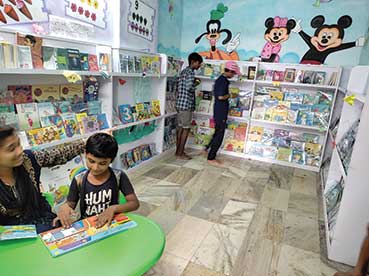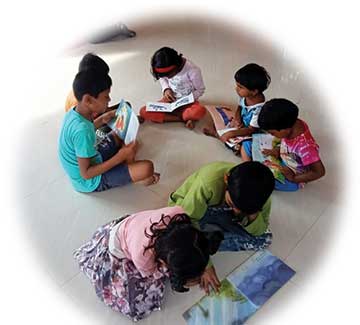Sajitha
“What is a library?” is a question we never ask ourselves. Our understanding of the library is minimal and limited to the stack of books in school. Despite working in the education sector for 10 years, I too had never questioned the concept of a ‘children’s library’. There was never a doubt that a large number of books should be part of the classroom, but is making books available to children enough in a library? We bought books that we believed would help children learn. For instance, children are learning to read English, hence books that had simple English were part of our library collection. Since children are not able to read words with conjunct consonants in Marathi, we bought books without conjunct consonants so that children will ‘benefit’ from our collection. These were some of the criteria with which we selected books because I was sure ‘I understand my students better’ and hence bought books that I knew they would be able ‘to read’.

This approach of looking at the collection in a library is coming from a person who is ‘a reader’, may not be a voracious one, but I enjoy and have had a very dear connection with books from childhood. My students browse through books when brought to them and even try to read, but no one remembers or has a favourite book.
The first day of my Library Educator Course at Bookworm (LEC) reminded me of this connection with books and its power. We reflected on our bonding with books and the strength of that bonding. The LEC journey helped me understand what the library as an institution can achieve, its strength, who has contributed to it and how. When you gain this knowledge and realize that what you have been doing is inappropriate or limited, you know that you need to make it right and therein started my journey as a library practitioner.
While learning the course, Bookworm helped us visualize what we are learning. And since the course was process driven, many learnings emerged through discussions and presentations. Sujata, Usha, Jane, and Teju (our mentors for the course) shared their journeys as library practitioners and they did it using children’s books.
My plan was to open a library specifically for children in Kalyan, Maharashtra. Both at the personal as well as at the organizational level, I had to take decisions that I was not happy with, keep silent when I wanted to shout, and above all did not know what I was angry about, with whom or what to do about it. Building a library needs huge investment. I did not have that capacity. Luckily, I found a partner who envisioned a library for children. An avid reader herself, Rutu Maharshi, shared how books helped her stay positive and happy during the 2001 earthquake in Gujarat. Her passion for bringing books to needy children and her network of people who were willing to invest in our project was crucial for building the library. Her organization, SPARSH TRUST works in the education sector in Gujarat and supports smaller organizations working in the education sector. With Rutu’s support, the library was actualized. We named it EnRead.

A physical library, however beautiful, has no life until it has an apt librarian. For almost eight months, we struggled to get a good librarian. I appointed someone who was willing to work with the given honorarium and time limit. I believed that training would help her become a good librarian. My own absence due to my pregnancy did not help in the librarian’s capacity building. The quality of the library was affected. It became more of a daycare centre. The librarian was not able to convey the objective of the library as she herself did not know what it was or had not internalized it. That initial phase was both positive and negative for us. The place welcomed children. They would make the librarian read their favourite story books. Another positive impact was that new parents started asking about the library and this led to defining and sharing the objectives of the library with my team. We conducted activities and workshops for children. The LEC team helped me with this during my maternity leave.
After I rejoined on a full-time basis, capacity building of the team began. The following month though, the trained librarian resigned. The new librarian is an arts graduate by qualification, is an avid reader and has had some experience working with children. When working in an urban area and with minimal resources, getting highly skilled people is always a struggle. The new librarian’s interest in reading and interacting with children has improved the quality of the library. Our library is now set and the membership is also growing. Parents are happy that their children have access to books in their mother tongue, Marathi. One of the parents mentioned that her seven year old started reading Marathi because of the interesting story books here. Arya, a 4 year old member of our library, after a week-long vacation wanted to come to the library first even before going home. Parents who are worried about children’s technology addiction look to the library as a space for their children to connect with other interests.
Victor Sensenig, an educator and researcher, in his article (Sensenig, 2017)* which we read as part of our LEC course, envisaged the role of the library as an invaluable collaborator with schools and communities. He explains how in America, the role of the library in a school’s achievement was realized and the country started investing in libraries. With NEP 2020, India is now starting to focus on quality education and this is the moment to recognize the role of the children’s library. Investment in children’s collections in public libraries and in every school should be made mandatory. At SAJAG (an organization that works with low-income communities in Kalyan, Maharashtra and helps them access basic quality education), our mission is to partner with schools and public libraries in Kalyan. We have started our work in this direction. To begin with, we shared my learnings at LEC with the teachers at a school we have been closely associated with and had a fruitful discussion on how books shaped our lives. A regular discussion with teachers, schools, public libraries, and a way forward to strengthening existing libraries and making them more accessible and of better quality is our next mission.
*Sensenig, V. (2017). Reading First, Libraries Last: An Historical Perspective on the Absence of Libraries in Reading Education Policy. SAGE Journal of Education.
The author is co-founder of SAJAG. She can be reached at sajitha@sajagtrust.org.
